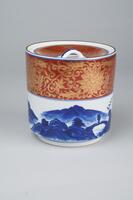133 UMMA Objects
133 UMMA Objects

Korean (Korean (culture or style))
Tea Bowl, 'ido chawan' type
16th century
Bequest of Margaret Watson Parker
1954/1.535
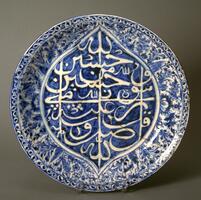
Ali ibn al-Hajj Muhammad
Platter with an inscription from a Hadith [a saying of the Prophet Muhammad], signed by Ali ibn al-Hajj Muhammad
1600 – 1799
Transfer from the College of Architecture and Design
1972/2.158
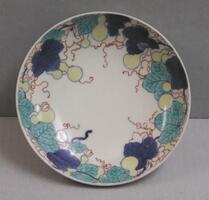
Artist Unknown, Nabeshima ware, Japan
Plate with gourd and vine design (one of five with 1964/1.100 and 102-104)
1700 – 1732
Museum purchase made possible by the Margaret Watson Parker Art Collection Fund
1964/1.101

Chinese (Chinese (culture or style))
Bowl
1573 – 1619
Museum purchase made possible by the Augusta Plumer Weiss Memorial Fund
1977/2.19
![It has a small straight rim. Abstract flowers is decorated on the shoulder in the cobalt blue. The body shapes octagonal form.<br />
<br />
This white porcelain jar has an octagonal body and is decorated with vignettes in underglaze cobalt blue on the upper part of the shoulder. Its recessed base, created by removing clay from the bottom, retains traces of fine sand support. This angular bottle was shaped using a mold and has a strong sheen. A large number of cracks and contaminants, however, have darkened the surface. The clay is well sintered, forming a sturdy body.<br />
[Korean Collection, University of Michigan Museum of Art (2014) p.175] It has a small straight rim. Abstract flowers is decorated on the shoulder in the cobalt blue. The body shapes octagonal form.<br />
<br />
This white porcelain jar has an octagonal body and is decorated with vignettes in underglaze cobalt blue on the upper part of the shoulder. Its recessed base, created by removing clay from the bottom, retains traces of fine sand support. This angular bottle was shaped using a mold and has a strong sheen. A large number of cracks and contaminants, however, have darkened the surface. The clay is well sintered, forming a sturdy body.<br />
[Korean Collection, University of Michigan Museum of Art (2014) p.175]](/media/W1siZiIsIjIwMjIvMDUvMjUvNWRldWpibGR1MF9kZWZhdWx0LmpwZyJdLFsicCIsInRodW1iIiwiMjQweDIwMCJdXQ?sha=1263f52c62ec2d4b)
Korean (Korean (culture or style))
Small faceted bottle
1850 – 1899
Gift of Mrs. Caroline I. Plumer for the James Marshall Plumer Collection
1977/1.196

Korean (Korean (culture or style))
Blue-and-white octagonal water dropper with floral design
1850 – 1899
Gift of Mrs. Caroline I. Plumer for the James Marshall Plumer Collection
1977/1.197
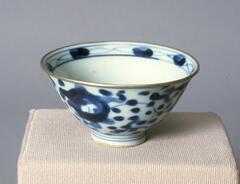
Chinese (Chinese (culture or style))
Blue-and-white tea cup with abstract floral design (1 of 5)
1400 – 1599
Bequest of Margaret Watson Parker
1954/1.519
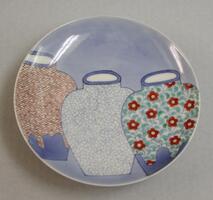
Artist Unknown, Nabeshima ware, Japan
Plate with three vase design (one of five with 1964/1.100-103)
1700 – 1732
Museum purchase made possible by the Margaret Watson Parker Art Collection Fund
1964/1.104
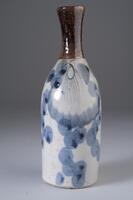
Japanese (Japanese (culture or style))
Small Sake Tokuri or Vase
1867 – 1932
Gift of Ann Holmes
2013/1.332

Japanese (Japanese (culture or style))
Portable tea ceremony set - whisk case
1850 – 1900
Gift of Ulrich and Sarah Straus
2013/2.82D

Japanese (Japanese (culture or style))
Portable tea ceremony set - tea scoop (chashaku) bag
1850 – 1899
Gift of Ulrich and Sarah Straus
2013/2.82N
Loading…
